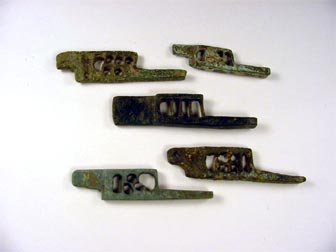Peter Fischer
The “Lord of the Locks,” Peter Fischer, was a British collector of weight. His huge collection of extremely high-class forged locks from the Middle Ages until the 20th century was auctioned off at Sotheby’s in Amsterdam in December 1998.
Christian Hammer’s lock collection
Christian H Hammer (1818–1905) was a court jeweler to Sweden’s royal family, a real estate agent, and a major collector. He was born in Christiania (Oslo) and was a journeyman goldsmith there in 1838. He came to Stockholm in 1849–50.
In 1897, an illustrated family magazine, For Swedish Homes, printed a free supplement in connection with the Art and Industry exhibition in Stockholm that year, which described Hammer’s collection.
One can now choose to continue straight ahead to Hasselbacken or up to Byströmska House, which has also been incorporated with the exhibition area and within whose walls lies the rest of the great Art and Cultural Historical collection which Mr. Christian Hammer has brought together and has not yet sold abroad; an impressive and interesting collection of objects, mainly of particularly Swedish interest (paintings, furniture, and mementoes of famous Swedes). The original collections, which were widely known under the name of “Hammer’s Museum” and were housed here in Byströmska House and in the 20-room house Number 2 Drottningsgatan, were so extensive that one could without exaggeration count them as one of the most significant individual collections in Europe. How these collections came to be split up, so that what now remains of them can be housed entirely in Byströmska House, is beside the point. Yet in these remains an art connoisseur will find rich material that should be of such great interest that it would be a great loss for him to have missed it at the low cost of admittance.
The collection in its entirety as it stood at the end of October 1869 was found to contain, not including duplicates, 64,920 items grouped into 8 main divisions: antiquities, sculptures, weapons, instruments of torture, art, Applied Art, objects for ecclesiastical and individual religious use, manuscripts and printed books, and miscellaneous. These main divisions were further divided into 50 groups according to type. Some examples of items in the Swedish collection are included as illustrations in this booklet. It is our hope, and probably that of the owner as well, that all or at least most of this collection remain national property, housed and organized in this lovely House.
For 25 years, Hammer built up and catalogued two different collections, one of art history and applied art, containing some 100,000 pieces and over 100,000 book volumes, autographs, and manuscripts. The cultural historical collections were displayed and organized in a private museum in Byströmska House, Hammer’s apartment in Stockholm and in Furusund.
The collections were sold at auctions in Cologne in 1892–1893 after first being offered to the Swedish government. Another magazine, Familje-Journalen (volume XIII, 1874, no. IV), said that the collections were practically a museum of applied art, featuring not only paintings, but also objects made of wood, metal, stone, glass, and more. Hammer himself guided visitors through the collection. Of the many locks and keys that were sold, the Nordic Museum in Stockholm bought a large number.
 |
| A collection of Roman lock bolts of bronze, circa 200 AD. Photo by the author. |
Heinrich Pankofer’s key collection
Another German collector was locksmith Heinrich Pankofer (18??–1998?). A chimneysweep’s son, he grew up and learned his profession in Munich. His interest in collecting was kindled during a vacation to Turkey, when he was wandering the bazaars of Istanbul and found a Roman-Era key. For 50 years, he systematically built up a valuable collection, which embraced over 1,000 objects and 2,000 years of development of mainly keys and also locks.
The collection was auctioned off in Munich in winter 2001, with a starting price of one million deutschmarks (about $525,000 today). The collection contained a representative selection of key styles throughout history, including a number of door locks, chest locks, and iron chests and boxes.
In addition, the collection contained padlocks from a range of cultural areas and purposes, for boxes, chests, and doors. These included padlocks from the Roman Empire (with finger-ring keys) in animal form, horse-shaped Oriental padlocks for slide and push keys, Chinese keys with (split) spring lock function, an Indian padlock for a screw key, German Renaissance padlocks with various locking mechanism, empire padlocks with combination locks, and many others. One curiosity is a small Gothic spherical keyed padlock, measuring just five millimeters in diameter, perhaps the world’s smallest lock from this era? A contrasting piece is an eighteen-centimeter high, five-kilogram baroque padlock from Vienna.
In 1928, master locksmith Heinrich Pankofer started his own company, called Pankofer & Kaufman. His daughter Emmi and her husband Hubert Seifert took over the business in 1971 and have a staff of some 30 locksmiths today. Another of Pankofer’s daughters, Marlene, is married to Fritz Nüssel, who runs another lock company in the same city.